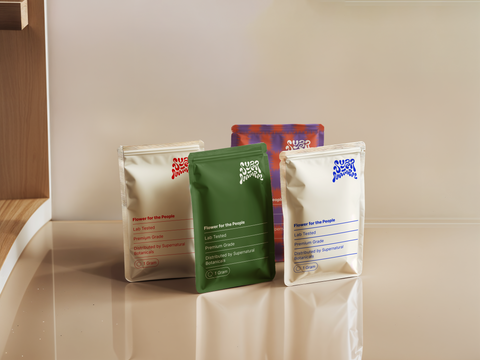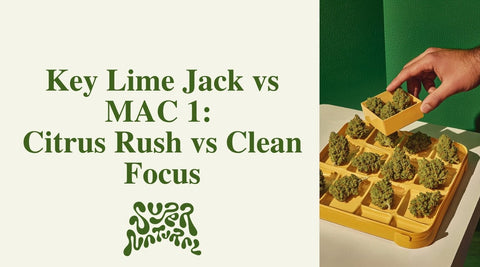
Terpenes are aromatic compounds found in cannabis and other plants. They give strains their unique scent and may interact with cannabinoids to influence effects. Over 100 terpenes exist in cannabis, each contributing to aroma, flavor, and possibly therapeutic benefits.
Terpenes Are the Reason Why Cannabis Smells the Way It Does
Open a jar of flower and the first thing that hits is the aroma. Sharp citrus, pine resin, diesel, or something floral and herbal. That’s terpenes doing their thing. These aromatic compounds show up in nearly every plant, but in cannabis, they shape the entire experience.
Terpenes influence how weed smells, how it tastes, and how it lands in your body. They’re a major part of why one strain helps you focus while another sends you straight into the couch.
While THC tells you about potency of the strain, terpene profiles point to how the flower might actually make you feel.
Here are five terpenes that matter most when it comes to top-shelf flower:
-
Myrcene: earthy and deeply relaxing
-
Limonene: citrus-bright and mood-lifting
-
Pinene: forest-scented and mentally clear
-
Beta-Caryophyllene: spicy and soothing
-
Linalool: floral and emotionally grounding
Every flower at Stay SuperNatural is lab-tested for its terpene profile, not just cannabinoids or contaminants. We work directly with craft growers, pull full-panel reports, and only move forward when the results hit the mark.
The flower we choose doesn’t just smell amazing, it delivers the experience you’re looking for.
Up next, we’ll dig into what terpenes are made of, where they show up in nature, how they evolve in cannabis, and how they help define each strain’s unique fingerprint.
Terpenes In Nature: The Invisible Aromatics
Long before terpene profiles were listed on cannabis jars, these molecules were working behind the scenes in almost every plant on Earth. Terpenes are part of the natural language plants use to interact with their environment.
From the tang of a grapefruit to the scent of crushed pine needles, you’ve experienced them whether or not you knew the name. In cannabis, they play a starring role. In nature, they are everywhere, and they’ve been shaping ecosystems for millions of years.
Chemical Structure
Terpenes are built from isoprene units, which are small five-carbon building blocks. Link those units together in different configurations and you get a range of aromatic compounds that vary in structure, scent, and behavior.
Most cannabis terpenes fall into two categories based on their size: monoterpenes and sesquiterpenes. These compounds are volatile, meaning they evaporate easily, which is why they are detectable through smell. They are also lipophilic, so they dissolve in fats and oils rather than water.
That combination of traits (aromatic, fat-soluble, and quick to evaporate) makes them ideal for both defense and attraction mechanisms in the plant world.
Botanical Ubiquity
Terpenes are not exclusive to cannabis. They are responsible for the citrus scent in orange peels, the relaxing aroma of lavender, the bite of fresh basil, and the crisp edge of rosemary.
They also give pine trees their sharp signature scent and help hops deliver that bitter edge in your favorite IPA. Because of these strong and often pleasant aromas, terpenes are used extensively in perfumes, essential oils, and natural cleaning products.
The smell of a lemon-scented disinfectant or a minty balm? That comes from isolated or synthetic terpenes engineered to mimic what nature already does perfectly.
Evolutionary Purpose
For plants, terpenes aren’t just for show. They act as chemical defenses, helping to protect against insects, mold, and harmful bacteria. They can signal danger, attract beneficial organisms, or even communicate with neighboring plants.
Some terpenes draw in pollinators with their scent, while others warn predators that a plant is not worth the bite. In cannabis, the diversity of terpene expression is a direct result of this evolutionary adaptation.
Each strain developed its unique profile not just for aroma or flavor but as part of a long-term survival strategy that cannabis growers and connoisseurs now get to benefit from.
Why Are There Terpenes in Cannabis?
Terpenes in cannabis serve as more than just aromatic flair. They reflect the plant’s natural biology, genetic makeup, and post-harvest care. Each of these elements contributes to the unique results you get from different flower.
Where They’re Most Abundant

You can find terpenes packed inside trichomes, those resin glands that coat cannabis flower with visible crystals.
These glands produce the aromatic oils that you're sniffing when you pop open a jar. Stems and leaves contain much lower terpene levels, so high terpene content begins and stays in the buds.
How Each Strain Has a Different Terpene Profile

Terpene expression depends on strain genetics, growing practices, and how flower is cured and stored. The same strain name may offer very different terpene ratios from one batch to another.
That variability underscores the need to check the Certificate of Analysis from lab tests rather than assume a strain will always smell or feel the same.
Try Our Best-Testing THCa Strains
Rancid Rainbow

Rancid Rainbow stands out for its dominant limonene profile. It delivers a heady lift followed by a grounded sense of calm that stays present instead of fading. Myrcene presence supports that mellow tail end while caryophyllene and pinene help balance effects with depth and clarity.
Caked Up Cherries

Caked Up Cherries leans into myrcene, giving a slow, full-body ease with a sweet herbal nose. That myrcene signature carries relaxation without heaviness that drags.
Drip Station

Drip Station brings a funk-forward terpene experience, mixing gas and pine with standout caryophyllene. The result feels full-spectrum, relaxed but alert, making it a versatile pick for those searching for balance.
5 Most Important Terpenes in Cannabis
Each terpene in cannabis offers more than a scent or taste. These compounds carry their own effects and energy. When you know which ones dominate a strain, you get a much clearer picture of how that flower might work for you.
These five terpenes are some of the most prevalent and meaningful in high-quality flower.
Myrcene
Myrcene is known for its earthy, musky aroma with soft fruit undertones. It appears frequently in cannabis and is associated with body-centered effects. Many strains that encourage physical ease or a sense of stillness tend to show strong myrcene levels.
This terpene also plays a role in easing inflammation, making it popular in strains used for physical recovery or rest. It often appears in flower labeled as indica or nighttime leaning, but the experience will always depend on the full profile it shares space with.
Limonene
Limonene brings a bright citrus aroma, similar to lemon and orange rinds. It is known for promoting an uplifted state and is often linked to stress relief. Many people choose limonene-dominant strains for daytime use, creative work, or social situations.
This terpene also shows potential for supporting the body’s natural anti-inflammatory response. A small number of users report sensitivity when exposed to high concentrations of limonene, particularly in concentrated forms like extracts or vapes.
Pinene
Pinene smells exactly like what it sounds like. This terpene carries a clear, forest-scented aroma often compared to pine needles or evergreen sap. Its presence in cannabis is tied to increased alertness, improved memory, and a more mentally clear experience.
It is found in many plants beyond cannabis, including rosemary, basil, and dill. Pinene is sensitive to temperature and time, which means flower that has been over-dried or poorly stored will often lose it first.
Beta-Caryophyllene
Beta-Caryophyllene delivers a spicy, peppery scent and interacts with the body in a rare way. Unlike other terpenes, this one can bind to CB2 receptors, the same system targeted by many cannabinoids.
That interaction is linked to relief from physical tension, making it a key terpene in strains designed for comfort or balance. Its presence in cannabis also complements other terpenes by adding depth and grounding to the aroma and effect profile.
Linalool
Linalool is easy to spot by its floral and slightly herbal aroma. It is also found in lavender and many traditional calming herbs. This terpene is associated with a soothing state, both physically and emotionally. People often seek it out in flower meant for stress, sleep, or unwinding.
Like all terpenes, it functions best when preserved in its natural form within the plant. In rare cases, certain individuals may notice sensitivity to linalool, which is why fresh, properly tested flower matters.
How Terpenes Impact the Cannabis Experience
When a strain feels smooth, balanced, or surprisingly effective, terpenes are usually involved. These aromatic compounds shape more than smell. They influence how cannabis hits, how the effects unfold, and how your body and mind respond.
From flavor to function, terpenes carry real weight in the smoking experience.
Aroma and Flavor
Terpenes are the reason cannabis smells like citrus, pine, herbs, or gas. They decide whether your flower is bright and zesty or deep and earthy. These scents are not just aesthetic. They help predict how a strain might land.
Someone drawn to fuel-forward aromas often seeks intensity, while a floral note might signal a softer ride. The way a flower smells can offer meaningful clues.
Many people find that the strains they love most all share similar terpene profiles, even across different names or lineages.
Do Terpenes Contribute to Psychoactive Effects
Terpenes do not cause a high on their own, but they interact with cannabinoids in ways that affect the overall experience. This interaction is often called the entourage effect.
A flower with the same THC percentage can feel very different depending on which terpenes are present. That is why THC alone cannot predict a strain’s true potential.
Some people notice sensitivity to certain terpenes. For example, linalool or limonene in high concentrations can occasionally lead to headaches or skin irritation. These reactions are rare and tend to occur more often with concentrated products rather than whole flower.
There is also curiosity about whether terpene effects can become less noticeable with regular use. The body may adjust to repeated exposure, but current science is still exploring this.
How Improper Curing Can Diminish the Impact of Terpenes
Terpenes begin to break down if flower is over-dried, stored without care, or left too long in poor conditions. If your weed smells flat or like hay, it likely lost much of its terpene content. Properly handled flower keeps its full expression.
The scent stays rich, the flavor remains complex, and the effects deliver what the strain promises. This is why full-panel testing and thoughtful storage matter at every step.
Learn How to Read the Terpene Signature
Terpenes shape the way cannabis feels, tastes, and functions. They carry the character of each strain and influence how your body responds to the plant.
Knowing which terpene profiles work for you turns buying flower into something more intentional. It brings clarity to your choices and consistency to your sessions.
Every jar from Stay SuperNatural comes from flower that’s been tested for more than potency. We verify terpene content, preserve it through careful storage, and only select strains that meet our highest standards.
If you want flower that smells alive, hits clean, and delivers what the label promises, start by looking at the full collection of lab-tested THCa flower available from our online store.





